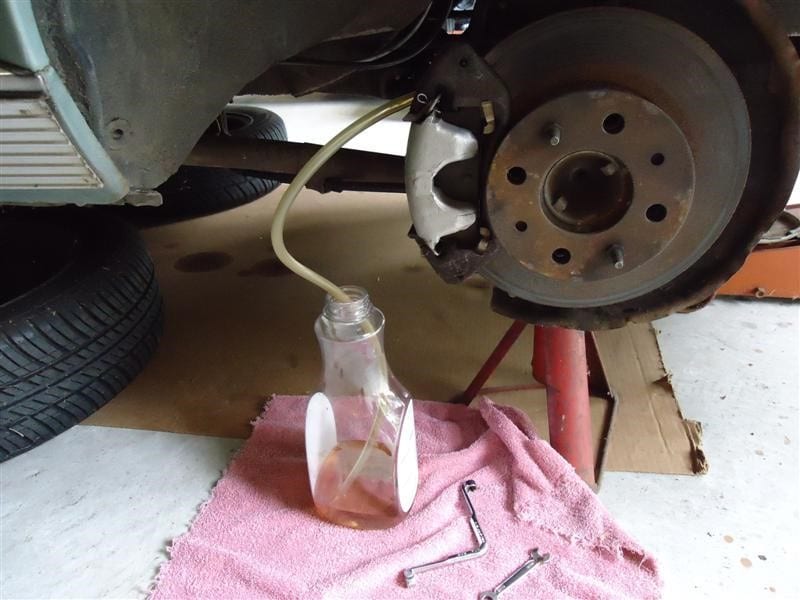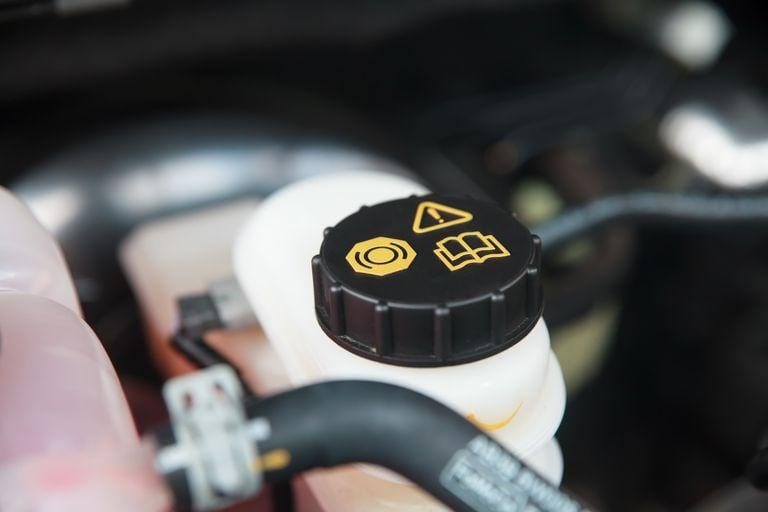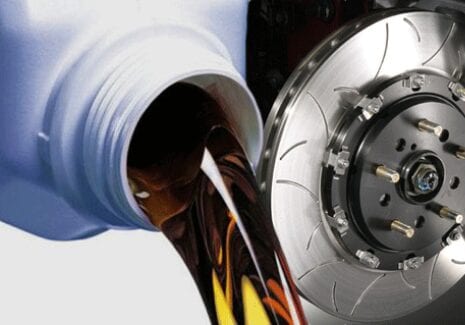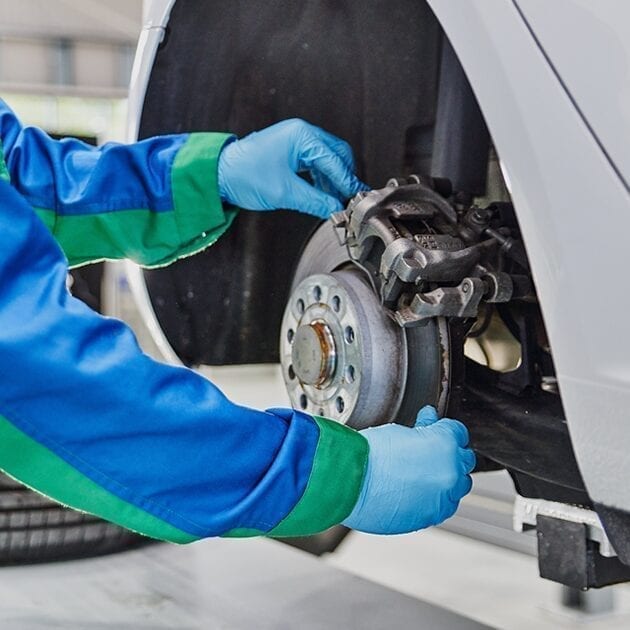
How does brake fluid change?
Content
Brake fluid is one of the main elements that ensure safety while driving. This allows you to transfer the force created by pressing the brake pedal directly to the wheels of the car, and if necessary, reduce its speed.
Like any other element of a car, brake fluid needs good maintenance and timely replacement in order to carry out its work properly.
Want to know how to replace brake fluid? We will tell you a little later, but first, let's deal with something else useful and interesting.
Why should special attention be given to brake fluid?
Brake fluid works under very difficult conditions. Even in a quiet city ride with the brake on, it heats up to + 150 degrees Celsius. And if you drive in a mountainous area, aggressively or, for example, tow a trailer, then it can heat up to + 180 degrees, and when stopped, its temperature can reach + 200 degrees Celsius.
Of course, brake fluid can withstand such temperatures and loads and has a high boiling point, but it changes over time. Her main problem is that it is hygroscopic. This means that it has the ability to absorb moisture from the atmosphere, which reduces its effectiveness.
Once the fluid begins to absorb moisture, it cannot effectively protect the components of the brake system from corrosion. When% of water increases, its boiling point decreases, so-called vapor bubbles are formed that do not allow the fluid to transmit the necessary pressure, and the brakes begin to fail.
When is it time to change the brake fluid?
2 years have passed since the last shift
Even if you do not notice any problems with the brake system of your car, if you care about your safety, it is highly recommended that you replace the brake fluid if you have traveled 40000 km. or if 2 years have passed since the last fluid change. Manufacturers not in vain recommend this period for a replacement. During these two years, the brake fluid ages and the percentage of water absorbed in it inevitably increases.
Stop is getting harder
If the car stops more slowly when you press the brake pedal, this is a clear signal that it is time to change the brake fluid. Usually a slower and more difficult stop is due to the fact that more water has accumulated in the liquid, which is why the boiling point of the liquid decreases significantly.

If the brake pedal is pressed softly or engages
If you are in this situation, you need to replace the fluid as soon as possible. Why? A “soft” brake pedal means that the% of water in the brake fluid has increased and steam bubbles have begun to form, which block the operation of the brake system.
When you apply the brake, instead of brake fluid, to provide the necessary force to stop the vehicle, these forces are redirected to compress the resulting water bubbles. This reduces the boiling point of the liquid, and instead of withstanding the temperature to 230-260 degrees, its boiling point drops to 165 degrees Celsius.
If brake fluid is discolored or dirty
If you feel that the brakes behave unnaturally while driving, look at the brake fluid. It is possible that its level is decreasing, and it is quite possible that the liquid changed color or corrosive particles got into it. If you notice something like this, consider replacing the brake fluid.
Important! Do not open the fluid tank to check the level. You can find out what it is by looking at the line showing the level on the tank. We say this because every time you open the tank, air and moisture enter it, and this, as it turns out, affects the effectiveness of the brake fluid.
How to check brake fluid condition?
The easiest way to check the condition of the fluid is to use special testers. Similar products are available at all auto parts stores and most gas stations, and their price is minimal.
Using a tester, you can determine the boiling point of a liquid. If after checking the tester shows a value of 175 degrees or more, this means that the brake fluid can still be used. If it shows values between 165 and 175 degrees, it means that you should think about whether to change it right now (especially if you used it for a year), and if the values show a boiling point below 165 degrees, it means you need to hurry with brake fluid replacement.

How does brake fluid change?
The procedure for replacing the fluid itself is not very complicated, but there are some nuances, and if you are not very aware of them, it is better to contact a specialized service. We say this not to force you to seek service at a service station, but because when changing brake fluid, actions such as venting and flushing the system, removing car wheels and others are necessary, and if the procedures are not performed professionally, this can lead to endanger your safety. In addition, the workshop will check the components of the brake system and run diagnostics on your vehicle in addition to changing the fluid.
Of course, leaving the replacement to the professionals is just a suggestion. If you want to do it yourself, here's how to change your brake fluid.
Liquid preparation and replacement
Before you begin, you will need a few things:
- new brake fluid
- convenient place to work
- soft transparent tube, the inner diameter of which corresponds to the outer diameter of the nipple of the wheel cylinder
- bolt wrenches
- something to collect waste
- clean, soft cloth
- assistant
The first thing you need to do is look in the technical manual of the car what brake fluid you need and purchase it.

Important! Do not use the old liquid that you drained. Also, do not use liquid that has not been tightly closed!
To keep calm, just buy a new bottle of brake fluid that matches the fluid you used in your car. Once you have prepared everything you need, you can move on to replacing the fluid.
In general, you should start the procedure by first removing the old fluid. To do this, you need to know what type of brake system you have installed. If your braking system is diagonal, then the pumping of fluid should begin first with the right rear wheel, then go to pumping from the front left wheel, then from the rear left and, finally, the front right.
When working with a parallel system, you must start from the right rear wheel, moving sequentially to the rear left, right front and, finally, front left wheel.
Fluid is removed by removing the vehicle wheel and opening the brake fluid drain valve. Once you find it, connect it to the pipe you prepared.
Slightly loosen the valve so that the pipe enters. During this time, your assistant should be in the car and apply the brakes several times until he feels resistance from the brake pedal. As soon as he senses tension and lets you know, loosen the drain valve so that fluid can flow through the tube. As the brake fluid leaks, your assistant should carefully monitor the movement of the pedal and tell you when the pedal reaches 2/3 of the way to the floor. As soon as the pedal falls 2/3 from the floor, lift the handset, start filling in new fluid, and when you are sure that the working fluid is completely clean and there are no air bubbles, close the exhaust valve and proceed to the next wheel in accordance with the brake system diagram.
To be 100% sure that you have successfully replaced the brake fluid, ask the assistant to sharply press and release the brake pedal, and also monitor the fluid level in the tank. If your assistant feels that the pedal is soft, or you see air bubbles forming in the fluid, you will need to repeat the drainage procedure.
After you have drained all the wheels and the pedal is OK and there are no air bubbles in the fluid, fill the tank with new fluid in accordance with the filling line. Wipe with a clean cloth, if you see that liquid has spilled around the tank, put the wheels of the car and be sure to do a quick test, going around the neighborhood to make sure that everything is in order.
To replace the fluid, you can also use a vacuum pump, which will save you time, but at the cost of changing the fluid at home it will cost you more because you have to buy a vacuum pump.

In custody
Timely replacement of brake fluid will relieve you of nerves and stress on the road and, above all, ensure your safety.
Do not forget to check it and replace it with a new one, at the first sign that something is wrong with the brake system of your car.
- Always use this brake fluid recommended by the manufacturers.
- Never mix glycol-based fluid and silicone-based fluid!
- Be very careful when changing fluids yourself and always check the brake system after replacement.
- If you are not quite sure that you know how to change the brake fluid, or are not sure that you can handle it completely efficiently, it is better to leave it to specialists.
Questions and answers:
How do you know when you need to change the brake fluid? The car began to slow down worse, but there is a sufficient level in the tank. The recommended expiration date has passed. Traces of corrosion appeared on the elements of the system.
How long can you not change the brake fluid? In most cars, the interval between brake fluid changes is about 40 thousand kilometers. For premium and sports cars - no more than 20 thousand
Why does the brake fluid change? With intensive work of the brake system, the fluid in the circuit can heat up to 120-300 degrees due to strong compression. Over time, the liquid loses its properties and can boil.

